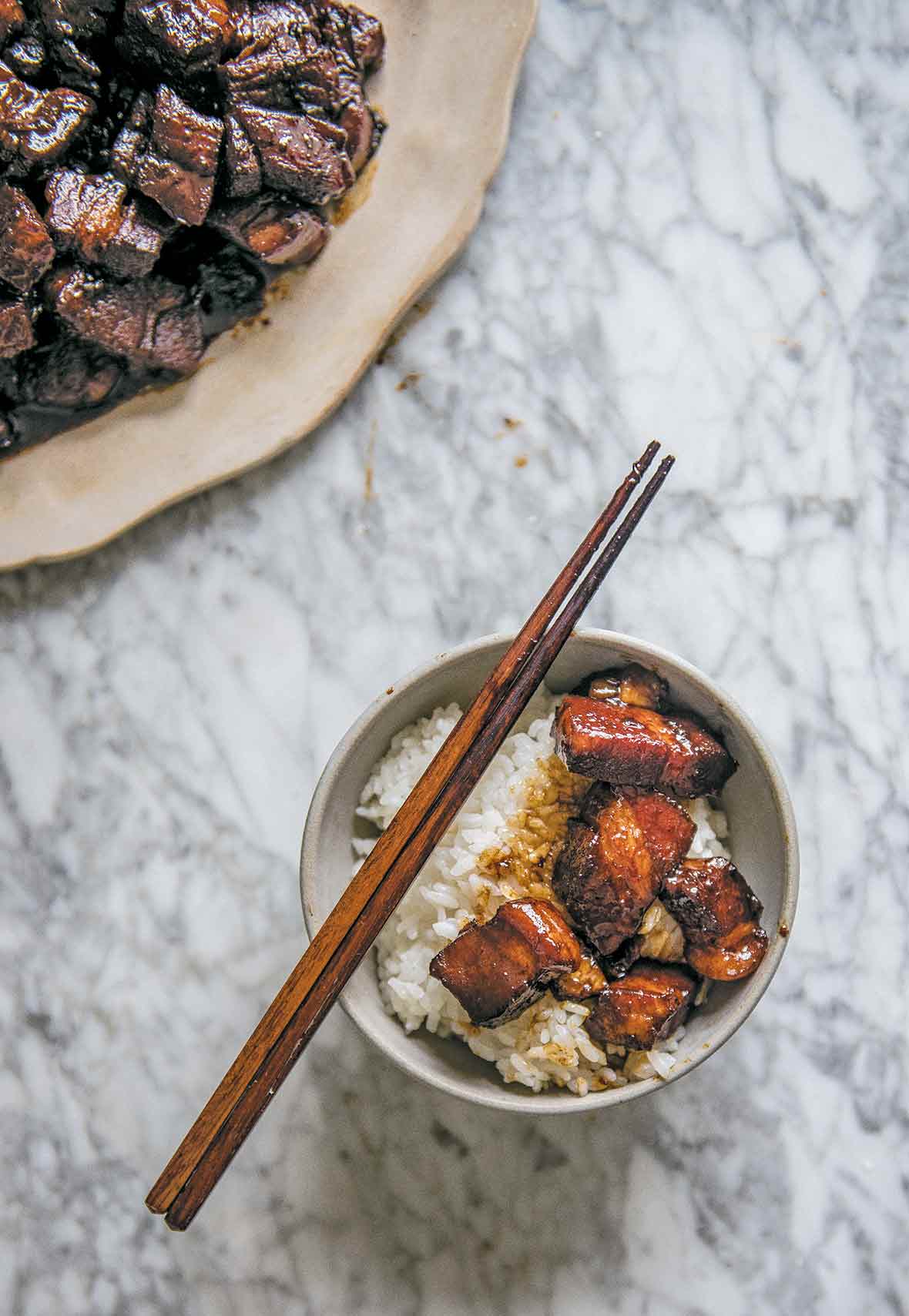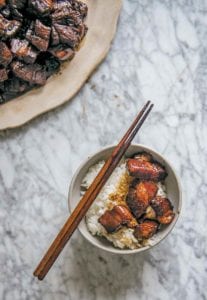
Red cooked pork, or Hong Shao Rou, is a trademark Chinese dish named for the glossy sauce that clings to sigh-inducingly tender braised pork. Our testers couldn’t get enough of the sweet, salty, subtly spiced sauce that bestows full-on richness to such a simple, yet superbly satisfying, Chinese classic.–Jenny Howard
*What Is Dark Soy Sauce?
This recipe calls for both light (regular) soy sauce and dark soy sauce. Dark soy sauce contains molasses or caramel and is aged for a longer time, resulting in a more complex taste and a slightly more viscous consistency. It’s what lends red cooked pork its signature dark glaze. Dark soy sauce can be found at some grocery stores and at any Chinese supermarket (or, like everything else on the planet, on Amazon). You can easily substitute an equal amount of light (regular) soy sauce and a teaspoon or so of molasses to approximate the rich flavor of dark soy sauce.
Want to Save This?
☞ Like pork recipes? Try these:
- Vietnamese-Style Caramelized Pork
- Braised Pork in Red Chile Sauce
- New Mexican Red Pork Chili
- Chinese Roast Pork

Red Cooked Pork
Ingredients
- 2 pounds pork belly or pork shoulder or a combination, cut in 3/4- to 1-inch (2- to 2.5-cm) chunks
- 1/4 cup granulated sugar, plus more to taste
- 2 tablespoons plus 2 to 3 cups water
- 3 to 4 scallions, cut on the diagonal into 2-inch (5-cm) lengths (about 1/4 cup sliced)
- 3 to 4 garlic cloves, smashed, or 1 tablespoon minced garlic
- 1 inch piece ginger root, sliced into 6 to 8 circles
- 3 whole star anise
- 1/3 cup Shaoxing rice wine, dry sherry, or sake
- 3 tablespoons light (regular) soy sauce, plus more to taste
- 3 to 4 teaspoons dark soy sauce* (see NOTE above)
- Cooked rice, for serving
Instructions
- Bring a large pot of water to a boil over medium-high heat. Add the pork and gently boil for about 10 minutes, skimming off any scum as it forms on top of the water. Drain the pork and rinse to remove any remaining scum.
- In a large wok or cast-iron skillet over medium-high heat, combine the sugar and 2 tablespoons water and stir until it dissolves. Tilt the wok or skillet to swirl the mixture, without stirring, just until it bubbles and begins to turn slightly darker in certain spots, 4 to 5 minutes. Be sure to watch it carefully so that the sugar doesn’t burn as the sugar can turn from brown to black in seconds.
- Add the pork and cook it with the caramelized sugar, stirring frequently, until the pork is browned and smells fragrant, about 4 minutes.
- Add the scallions, garlic, ginger, and star anise and toss for 1 to 2 minutes to give the aromatics a quick cook. Add the rice wine, both soy sauces, and enough water to cover the pork, about 2 to 3 cups. Stir to combine and then cover and ever-so-gently simmer the pork over low heat until tender, at least 1 hour and, for maximal sublime tenderness, for up to 2 hours.
- Once the pork is tender, take a look at the cooking liquid. If you prefer a thicker sauce, transfer the pork to a plate, return the heat to medium-high, and simmer, uncovered, until the sauce reduces to the desired consistency, 10 to 15 minutes. Be careful not to reduce the sauce too far as you’re going to want generous servings of the sauce to go over the pork and rice. Taste the sauce and, if desired, adjust with more soy sauce or sugar. Spoon the pork and sauce over rice. (You can refrigerate or freeze leftovers and gently rewarm it.)
Explore More with AI
Nutrition
Nutrition information is automatically calculated, so should only be used as an approximation.
Recipe Testers’ Reviews
This red cooked pork recipe really surprised me. I loved how easily it comes together and, for a recipe with relatively few ingredients, it’s SO flavorful. I’d suggest not reducing the sauce too much as it’s really good when you serve this with rice.
I used boneless rib-end chops and dry sherry. I used regular light soy sauce (6 tablespoons) plus 1 tablespoon molasses.
Tasted great the day of and great the day after. I’d LOVE it if it was a little saucier, though, as by the second day there was practically no sauce left.
I served this dish on an extremely cold and windy night and it got a great reception. The heat imparted by the ginger was nicely balanced by the sweetness of the sugar and the star anise. I watched as the plates got cleared.
I used pork shoulder cut into 1-inch chunks. I actually cooked the dish for an hour and a half and the pork was melt-in-your-mouth tender. I used dry sherry as I could not find the rice wine suggested.
My leftovers were very limited, a sign of how well received the dish was, and they reheated nicely for lunch the next day.
Red cooked pork is one of my favorite dishes but I’ve never thought to make it myself as I assumed it would be complicated or take hours. However, this recipe has made me reconsider that and I will definitely be adding it to my rotation. This is a simple recipe that produces deep, rich and flavorful pork. You definitely need to eat this with some rice as the combination is amazing.
If you have the time, I would recommend stewing this closer to 2 hours as suggested for more tender meat, but it’s delicious already after only 1 hour. Also, as mentioned in the recipe, it’s perfectly fine to use all light soy sauce if you don’t have dark soy sauce on hand.
This can definitely serve more than 6 along with rice given how intense the flavor is. I agree that the flavors do improve with time as I had it again the next day and it tasted even more rich.
This red cooked pork is a very deeply flavored stew that is very simple to make. I used a mixture of pork shoulder and belly. My favorite was the belly but my wife and kids enjoyed the less fatty pork shoulder a bit more. The rich meat, salty sauce, and the aromatic qualities of the star anise and ginger make for a very addictive plate of food. Both meats were delicious and went great with rice and roasted broccoli for dinner.
At the 2 hour mark the meat was tender. I left it in the pot with the heat turned off since it was not dinner time yet. I simply continued with the recipe an hour or so before dinner.
This can serve 4 comfortably and maybe 6 depending on what else you are serving with it.
I had never cooked a pork shoulder and now I realize what a huge mistake this was! This red cooked pork recipe is so good! As was the remaining fatty bits that I roasted and ate while I was making the red-cooked pork.
The recipe is easy to follow and gave me the confidence to make this dish even while using an unfamiliar cut of meat. The taste was definitely there. And, as the author suggests, the leftovers are even better. This made 6 good sized servings—4 for dinner and leftovers for 2 lunches.
Unfortunately, I couldn’t find the dark soy sauce, but I did use the substitution recommended and I really liked the flavor that the molasses added. I will try finding dark soy sauce but until then I’ll continue to make it with molasses.













What is the difference between Rice Wine and Sake? I should know this one!
Andi, rice wine and sake are grain alcohols derived from, obvs, rice. Rice wines can be distilled or fermented, while sake is only fermented.
This is a traditional dish that I’ve grown up eating, and one of my favourites! Rather than dark soy, the best option is thick soy or caramel soy which is super thick and sticky. I marinate my pork belly strips overnight in the soy, vinegar, etc. for maximum flavour. If I have time, I prefer to cook on low heat for 2+ hours in a CrockPot or the oven. I spoon off the fat after cooking. Serve with rice and greens–tada!
Enjoy…x
Thanks, Joanna. It sounds delicious!